Assessing consumer behaviour towards fish sauce products by using food choice questionnaire
This study aims to assess Vietnamese consumer behaviour towards fish sauce product.
It consists of two experiments. In the first experiment, consumer concept was explored using
word association method. It was performed on 300 Vietnamese consumers with the prompt word
as “fish sauce”. The data were analysed by a triangulation method. The results evoke six factors
associated with fish sauce as Sensory Appeal, Health, Price, Convenience, Traditional Value,
Quality and Safety. These findings were the starting point for a modification of food choice
questionnaire (FCQ) adapted to fish sauce product. In the second experiment, the modified FCQ
with 18 items was used to assess the consumer behaviour. The survey was performed on 300
Vietnamese consumers. The data were analysed by using Exploratory Factor Analysis and
Confirmatory Factor Analysis. The obtained model with five factors was adapted to fish sauce
for Vietnamese consumers ( ⁄ = 1.67, GFI = 0.93, CFI = 0.92, RSME = 0.47). In this,
Sensory Appeal is the most important factor which might affect consumer food choice
motivations. We expect that these results will be useful for the local manufacturers who want to
develop traditional food products and/or enlarge national market.

Trang 1
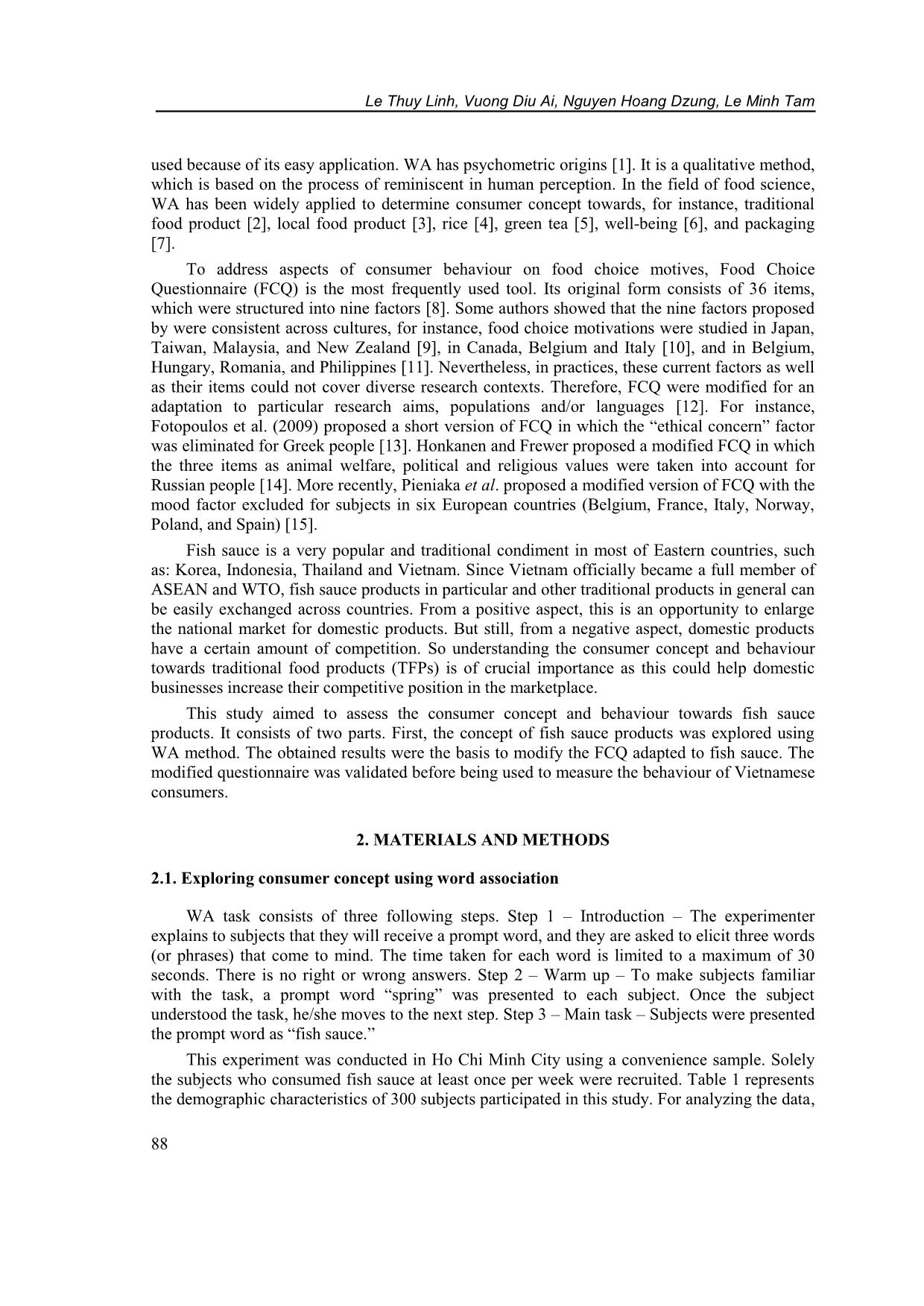
Trang 2
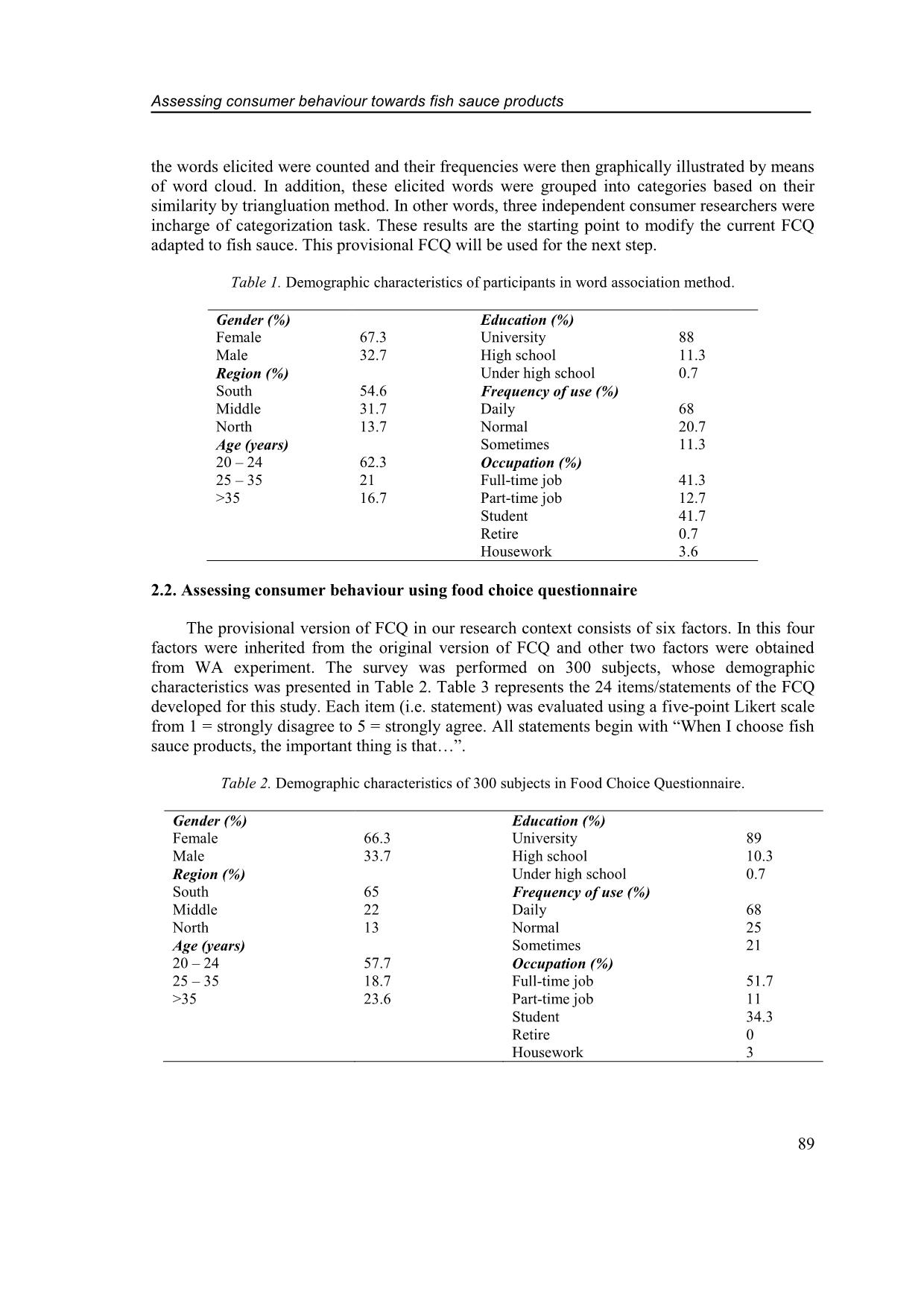
Trang 3
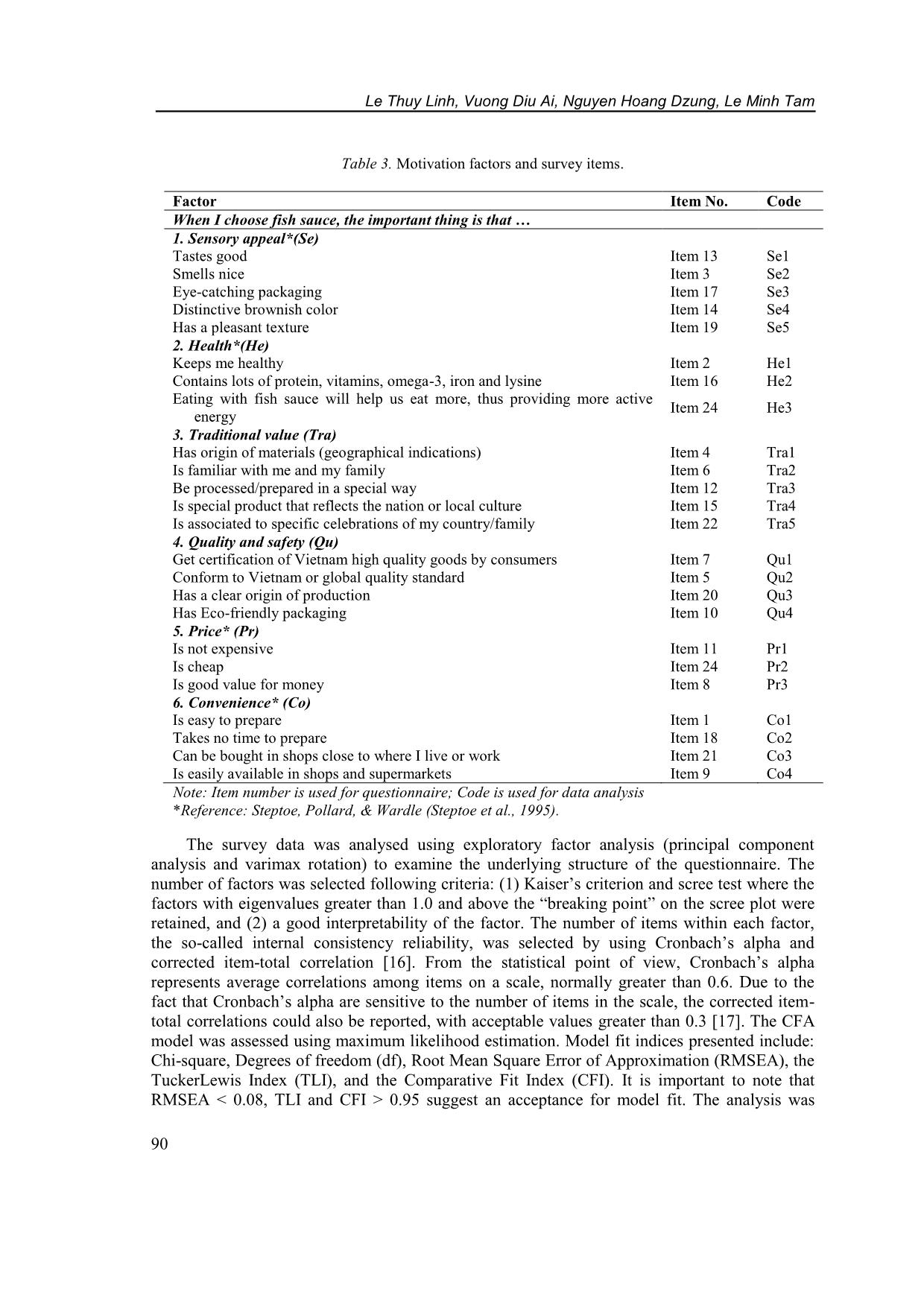
Trang 4
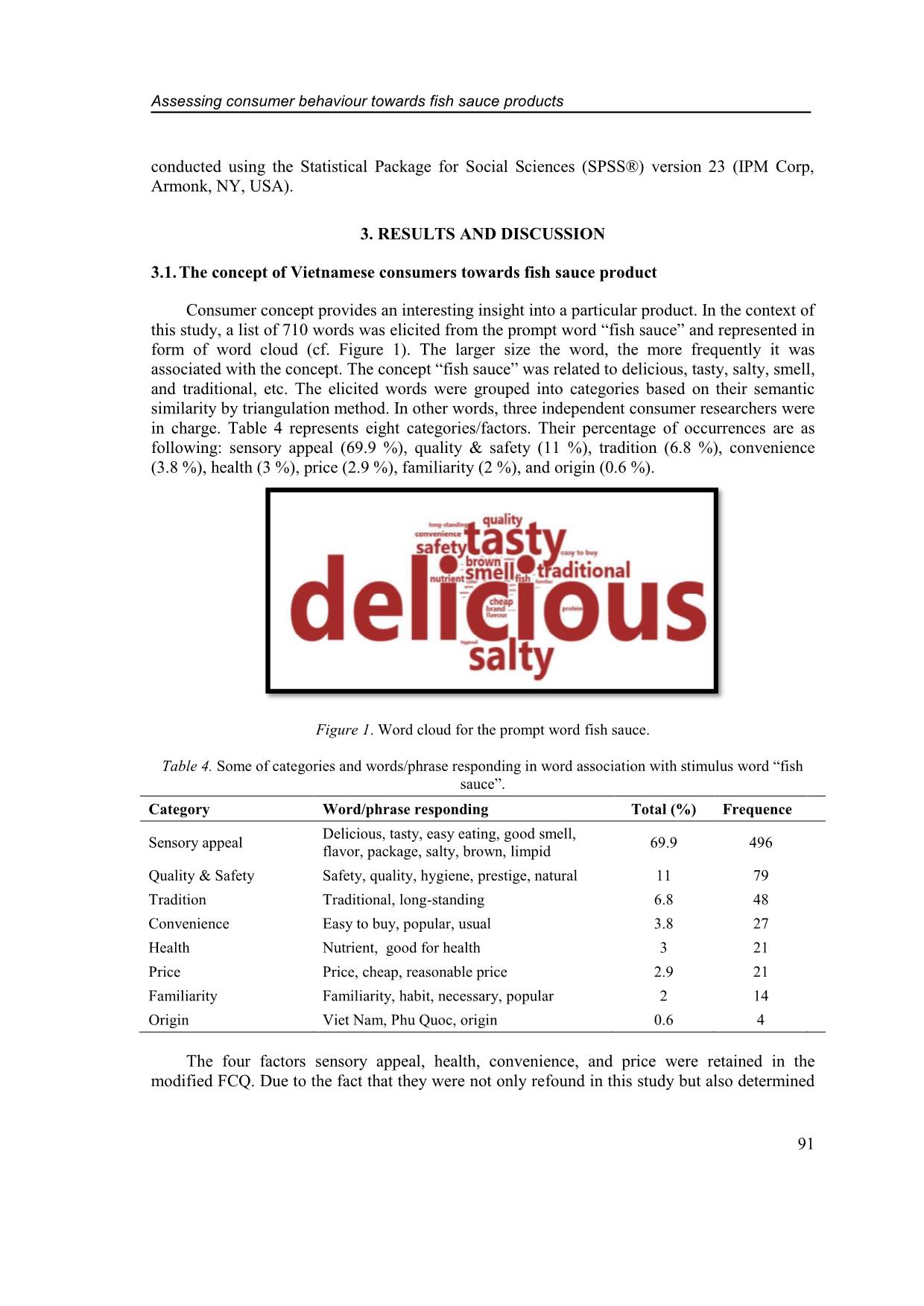
Trang 5

Trang 6
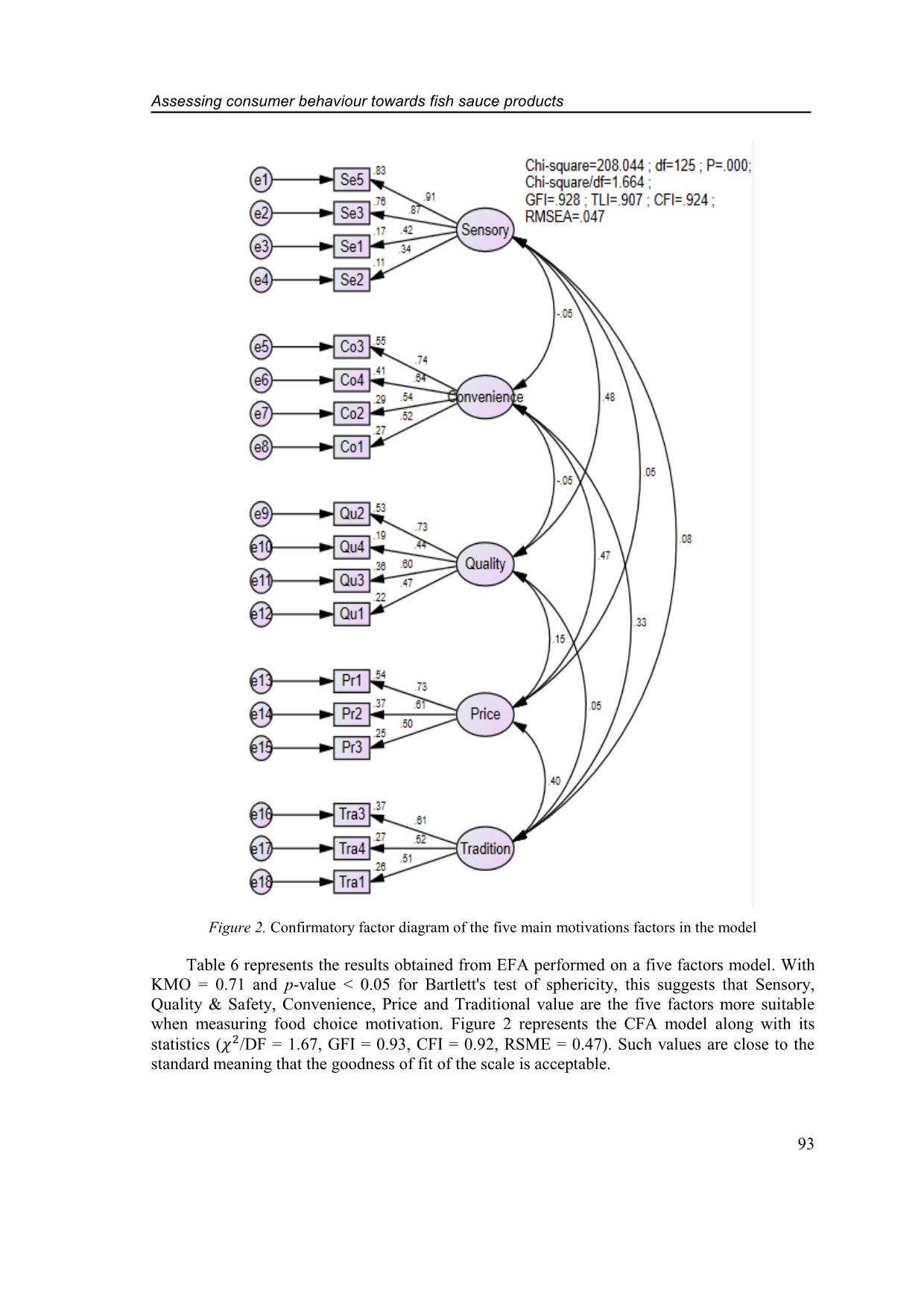
Trang 7

Trang 8
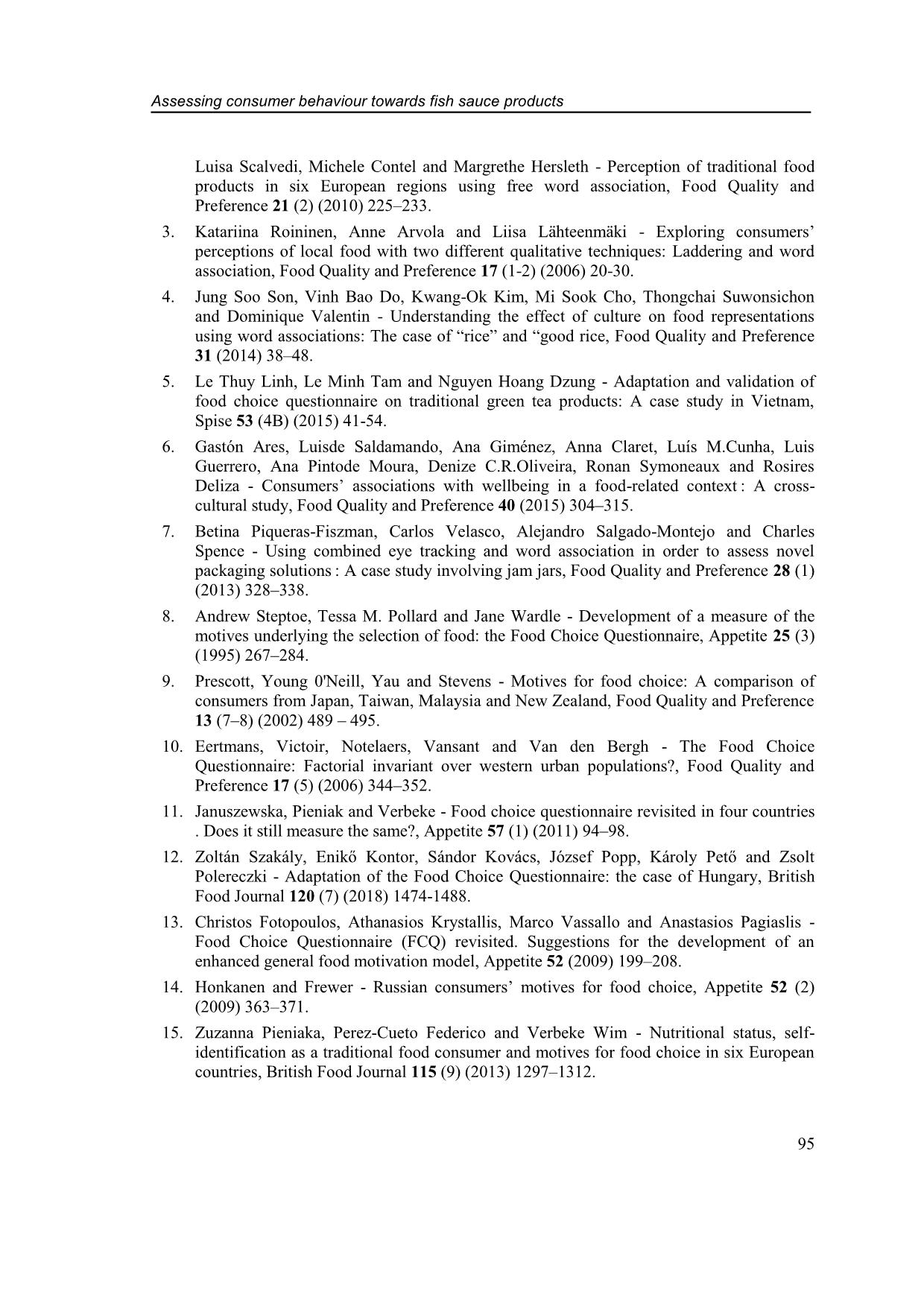
Trang 9
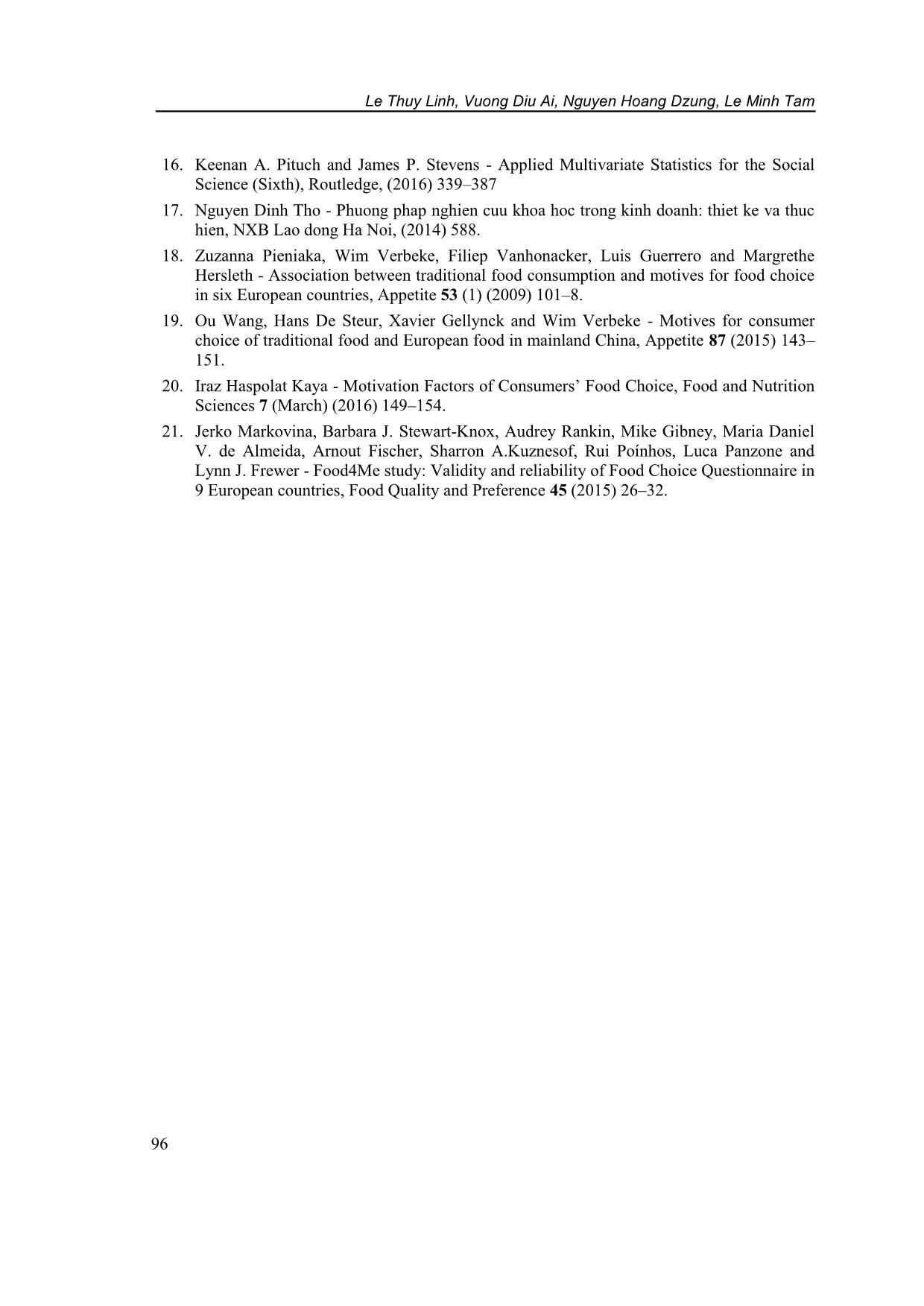
Trang 10
Tóm tắt nội dung tài liệu: Assessing consumer behaviour towards fish sauce products by using food choice questionnaire
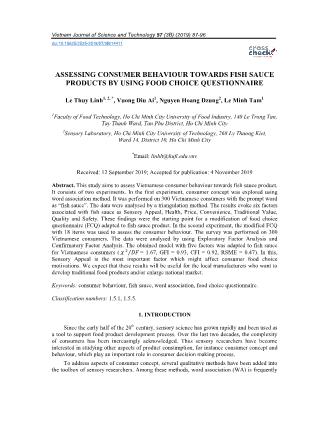
Vietnam Journal of Science and Technology 57 (3B) (2019) 87-96 doi:10.15625/2525-2518/57/3B/14411 ASSESSING CONSUMER BEHAVIOUR TOWARDS FISH SAUCE PRODUCTS BY USING FOOD CHOICE QUESTIONNAIRE Le Thuy Linh 1, 2, * , Vuong Diu Ai 1 , Nguyen Hoang Dzung 2 , Le Minh Tam 1 1 Faculty of Food Technology, Ho Chi Minh City University of Food Industry, 140 Le Trong Tan, Tay Thanh Ward, Tan Phu District, Ho Chi Minh City 2 Sensory Laboratory, Ho Chi Minh City University of Technology, 268 Ly Thuong Kiet, Ward 14, District 10, Ho Chi Minh City * Email: linhlt@hufi.edu.vnv Received: 12 September 2019; Accepted for publication: 4 November 2019 Abstract. This study aims to assess Vietnamese consumer behaviour towards fish sauce product. It consists of two experiments. In the first experiment, consumer concept was explored using word association method. It was performed on 300 Vietnamese consumers with the prompt word as “fish sauce”. The data were analysed by a triangulation method. The results evoke six factors associated with fish sauce as Sensory Appeal, Health, Price, Convenience, Traditional Value, Quality and Safety. These findings were the starting point for a modification of food choice questionnaire (FCQ) adapted to fish sauce product. In the second experiment, the modified FCQ with 18 items was used to assess the consumer behaviour. The survey was performed on 300 Vietnamese consumers. The data were analysed by using Exploratory Factor Analysis and Confirmatory Factor Analysis. The obtained model with five factors was adapted to fish sauce for Vietnamese consumers ( ⁄ = 1.67, GFI = 0.93, CFI = 0.92, RSME = 0.47). In this, Sensory Appeal is the most important factor which might affect consumer food choice motivations. We expect that these results will be useful for the local manufacturers who want to develop traditional food products and/or enlarge national market. Keywords: consumer behaviour, fish sauce, word association, food choice questionnaire. Classification numbers: 1.5.1, 1.5.5. 1. INTRODUCTION Since the early half of the 20 th century, sensory science has grown rapidly and been used as a tool to support food product development process. Over the last two decades, the complexity of consumers has been increasingly acknowledged. Thus sensory researchers have become interested in studying other aspects of product consumption, for instance consumer concept and behaviour, which play an important role in consumer decision making process. To address aspects of consumer concept, several qualitative methods have been added into the toolbox of sensory researchers. Among these methods, word association (WA) is frequently Le Thuy Linh, Vuong Diu Ai, Nguyen Hoang Dzung, Le Minh Tam 88 used because of its easy application. WA has psychometric origins [1]. It is a qualitative method, which is based on the process of reminiscent in human perception. In the field of food science, WA has been widely applied to determine consumer concept towards, for instance, traditional food product [2], local food product [3], rice [4], green tea [5], well-being [6], and packaging [7]. To address aspects of consumer behaviour on food choice motives, Food Choice Questionnaire (FCQ) is the most frequently used tool. Its original form consists of 36 items, which were structured into nine factors [8]. Some authors showed that the nine factors proposed by were consistent across cultures, for instance, food choice motivations were studied in Japan, Taiwan, Malaysia, and New Zealand [9], in Canada, Belgium and Italy [10], and in Belgium, Hungary, Romania, and Philippines [11]. Nevertheless, in practices, these current factors as well as their items could not cover diverse research contexts. Therefore, FCQ were modified for an adaptation to particular research aims, populations and/or languages [12]. For instance, Fotopoulos et al. (2009) proposed a short version of FCQ in which the “ethical concern” factor was eliminated for Greek people [13]. Honkanen and Frewer proposed a modified FCQ in which the three items as animal welfare, political and religious values were taken into account for Russian people [14]. More recently, Pieniaka et al. proposed a modified version of FCQ with the mood factor excluded for subjects in six European countries (Belgium, France, Italy, Norway, Poland, and Spain) [15]. Fish sauce is a very popular and traditional condiment in most of Eastern countries, such as: Korea, Indonesia, Thailand and Vietnam. Since Vietnam officially became a full member of ASEAN and WTO, fish sauce products in particular and other traditional products in general can be easily exchanged across countries. From a positive aspect, this is an opportunity to enlarge the national market for domestic products. But still, from a negative aspect, domestic products have a certain amount of competition. So understanding the consumer concept and behaviour towards traditional food products (TFPs) is of crucial importance as this could help domestic businesses increase their competitive position in the marketplace. This study aimed to assess the consumer concept and behaviour towards fish sauce products. It consists of two parts. First, the concept of fish sauce products was explored using WA method. The obtained results were the basis to modify the FCQ adapted to fish sauce. The modified questionnaire was validated before being used to measure the behaviour of Vietnamese consumers. 2. MATERIALS AND METHODS 2.1. Exploring consumer concept using word association WA task consists of three following steps. Step 1 – Introduction – The experimenter explains to subjects that they will receive a prompt word, and they are asked to elicit three words (or phrases) that come to mind. The time taken for each word is limited to a maximum of 30 seconds. There is no right or wrong answers. Ste ... Female 66.3 University 89 Male 33.7 High school 10.3 Region (%) Under high school 0.7 South 65 Frequency of use (%) Middle 22 Daily 68 North 13 Normal 25 Age (years) Sometimes 21 20 – 24 57.7 Occupation (%) 25 – 35 18.7 Full-time job 51.7 >35 23.6 Part-time job 11 Student 34.3 Retire 0 Housework 3 Le Thuy Linh, Vuong Diu Ai, Nguyen Hoang Dzung, Le Minh Tam 90 Table 3. Motivation factors and survey items. Factor Item No. Code When I choose fish sauce, the important thing is that 1. Sensory appeal*(Se) Tastes good Item 13 Se1 Smells nice Item 3 Se2 Eye-catching packaging Item 17 Se3 Distinctive brownish color Item 14 Se4 Has a pleasant texture Item 19 Se5 2. Health*(He) Keeps me healthy Item 2 He1 Contains lots of protein, vitamins, omega-3, iron and lysine Item 16 He2 Eating with fish sauce will help us eat more, thus providing more active energy Item 24 He3 3. Traditional value (Tra) Has origin of materials (geographical indications) Item 4 Tra1 Is familiar with me and my family Item 6 Tra2 Be processed/prepared in a special way Item 12 Tra3 Is special product that reflects the nation or local culture Item 15 Tra4 Is associated to specific celebrations of my country/family Item 22 Tra5 4. Quality and safety (Qu) Get certification of Vietnam high quality goods by consumers Item 7 Qu1 Conform to Vietnam or global quality standard Item 5 Qu2 Has a clear origin of production Item 20 Qu3 Has Eco-friendly packaging Item 10 Qu4 5. Price* (Pr) Is not expensive Item 11 Pr1 Is cheap Item 24 Pr2 Is good value for money Item 8 Pr3 6. Convenience* (Co) Is easy to prepare Item 1 Co1 Takes no time to prepare Item 18 Co2 Can be bought in shops close to where I live or work Item 21 Co3 Is easily available in shops and supermarkets Item 9 Co4 Note: Item number is used for questionnaire; Code is used for data analysis *Reference: Steptoe, Pollard, & Wardle (Steptoe et al., 1995). The survey data was analysed using exploratory factor analysis (principal component analysis and varimax rotation) to examine the underlying structure of the questionnaire. The number of factors was selected following criteria: (1) Kaiser’s criterion and scree test where the factors with eigenvalues greater than 1.0 and above the “breaking point” on the scree plot were retained, and (2) a good interpretability of the factor. The number of items within each factor, the so-called internal consistency reliability, was selected by using Cronbach’s alpha and corrected item-total correlation [16]. From the statistical point of view, Cronbach’s alpha represents average correlations among items on a scale, normally greater than 0.6. Due to the fact that Cronbach’s alpha are sensitive to the number of items in the scale, the corrected item- total correlations could also be reported, with acceptable values greater than 0.3 [17]. The CFA model was assessed using maximum likelihood estimation. Model fit indices presented include: Chi-square, Degrees of freedom (df), Root Mean Square Error of Approximation (RMSEA), the TuckerLewis Index (TLI), and the Comparative Fit Index (CFI). It is important to note that RMSEA 0.95 suggest an acceptance for model fit. The analysis was Assessing consumer behaviour towards fish sauce products 91 conducted using the Statistical Package for Social Sciences (SPSS®) version 23 (IPM Corp, Armonk, NY, USA). 3. RESULTS AND DISCUSSION 3.1. The concept of Vietnamese consumers towards fish sauce product Consumer concept provides an interesting insight into a particular product. In the context of this study, a list of 710 words was elicited from the prompt word “fish sauce” and represented in form of word cloud (cf. Figure 1). The larger size the word, the more frequently it was associated with the concept. The concept “fish sauce” was related to delicious, tasty, salty, smell, and traditional, etc. The elicited words were grouped into categories based on their semantic similarity by triangulation method. In other words, three independent consumer researchers were in charge. Table 4 represents eight categories/factors. Their percentage of occurrences are as following: sensory appeal (69.9 %), quality & safety (11 %), tradition (6.8 %), convenience (3.8 %), health (3 %), price (2.9 %), familiarity (2 %), and origin (0.6 %). Figure 1. Word cloud for the prompt word fish sauce. Table 4. Some of categories and words/phrase responding in word association with stimulus word “fish sauce”. Category Word/phrase responding Total (%) Frequence Sensory appeal Delicious, tasty, easy eating, good smell, flavor, package, salty, brown, limpid 69.9 496 Quality & Safety Safety, quality, hygiene, prestige, natural 11 79 Tradition Traditional, long-standing 6.8 48 Convenience Easy to buy, popular, usual 3.8 27 Health Nutrient, good for health 3 21 Price Price, cheap, reasonable price 2.9 21 Familiarity Familiarity, habit, necessary, popular 2 14 Origin Viet Nam, Phu Quoc, origin 0.6 4 The four factors sensory appeal, health, convenience, and price were retained in the modified FCQ. Due to the fact that they were not only refound in this study but also determined Le Thuy Linh, Vuong Diu Ai, Nguyen Hoang Dzung, Le Minh Tam 92 in other studies [18 - 21]. In addition, “traditional value” and “quality and safety” were found as the two new factors adapted to fish sauce, (cf. Table 2). 3.2. The food choice motives of Vietnamese consumers towards fish sauce product The internal consistency of the 24 items was assessed using Cronbach’s α and Corrected Item-Total Correlations. Table 5 represents Cronbach’s α values of six factors. As these values are greater than 0.6, it indicates a good internal consistency of the items within their factor, except for the health. Besides, the corrected item-total correlations are examined for their sign. As can be seen from the results, such recorded indices for the five factors were all positive. This suggests that the items were measuring the same underlying characteristics and none of them had been reverse-scored. Table 5. Measure of scale reliability. Factor Item Cronbach's Alpha Corrected Item-Total Correlation Mean Sensory Se1 0.744 .481 3.8 Se2 .392 Se3 .612 Se4 .407 Se5 .659 Health He1 0.451 .325 3.8 He2 .306 He3 .204 Traditional value Tra1 0.651 .316 3.9 Tra2 .434 Tra3 .457 Tra4 .418 Tra5 .392 Quality and safety Qu1 0.632 .362 3.8 Qu2 .527 Qu3 .423 Qu4 .353 Price Pr1 0.628 .543 3.6 Pr2 .435 Pr3 .343 Convenience Co1 0.704 .438 3.9 Co2 .458 Co3 .564 Co4 .500 Note: Cronbach's alpha on standardized items. Assessing consumer behaviour towards fish sauce products 93 Figure 2. Confirmatory factor diagram of the five main motivations factors in the model Table 6 represents the results obtained from EFA performed on a five factors model. With KMO = 0.71 and p-value < 0.05 for Bartlett's test of sphericity, this suggests that Sensory, Quality & Safety, Convenience, Price and Traditional value are the five factors more suitable when measuring food choice motivation. Figure 2 represents the CFA model along with its statistics ( /DF = 1.67, GFI = 0.93, CFI = 0.92, RSME = 0.47). Such values are close to the standard meaning that the goodness of fit of the scale is acceptable. Le Thuy Linh, Vuong Diu Ai, Nguyen Hoang Dzung, Le Minh Tam 94 Table 6. Exploratory factor analysis, item means, standard deviations, and item–total correlations. Item Factors Se. Con. Q & S Pr. Trad. M SD I-T Se5 0.880 3.70 0.819 0.659 Se3 0.847 3.58 0.867 0.612 Se1 0.601 4.03 0.813 0.481 Se2 0.539 3.91 0.831 0.392 Co3 0.762 3.85 0.821 0.564 Co4 0.731 4.04 0.817 0.500 Co2 0.659 3.91 0.740 0.458 Co1 0.636 3.83 0.695 0.438 Qu2 0.760 3.57 0.984 0.527 Qu4 0.676 3.80 0.918 0.353 Qu3 0.656 4.18 0.869 0.423 Qu1 0.586 3.80 0.851 0.362 Pr1 0.840 3.65 0.901 0.543 Pr2 0.731 3.25 0.932 0.435 Pr3 0.554 4.02 0.814 0.343 Tra3 0.754 3.90 0.824 0.457 Tra4 0.730 4.06 0.806 0.418 Tra1 0.623 4.23 0.735 0.316 Extraction Method: Principal Component Analysis. Rotation Method: Varimax with Kaiser Normalization. Abbreviation: EV: Eigenvalues; Cum.: Cumulative %; M: Mean; Se.- Sensory; Q&S- Quality & Safety; Con.-Convenience; Trad.-Traditional value, Pr.- Price 4. CONCLUSION This study highlights the food choice model with five factors (Sensory appeal, Quality & Safety, Tradition, Convenience, Price) adapted to fish sauce products for Vietnamese consumers. In this, Sensory Appeal is the most important factor which might affect consumer food choice motivations. In addition, this study retained two other important factors as “Quality and Safety” and “Traditional value”, which were mentioned previously in the publication of [5]. Further research could be conducted to determine invariant factors toward traditional food products across time and product categories, especially for Vietnamese consumers. From the application’s perspective, such factors are crucial in the context where the local manufacturers want to develop traditional food products and enlarge national market. REFERENCES 1. Francis Galton - Psychometric experiments, (1880) 2. Luis Guerrero, Anna Clareta, Wim Verbeke, Geraldine Enderli, Sylwia Zakowska- Biemans, Filiep Vanhonacker, Sylvie Issanchou, Marta Sajdakowska, Britt Signe Granli, Assessing consumer behaviour towards fish sauce products 95 Luisa Scalvedi, Michele Contel and Margrethe Hersleth - Perception of traditional food products in six European regions using free word association, Food Quality and Preference 21 (2) (2010) 225–233. 3. Katariina Roininen, Anne Arvola and Liisa Lähteenmäki - Exploring consumers’ perceptions of local food with two different qualitative techniques: Laddering and word association, Food Quality and Preference 17 (1-2) (2006) 20-30. 4. Jung Soo Son, Vinh Bao Do, Kwang-Ok Kim, Mi Sook Cho, Thongchai Suwonsichon and Dominique Valentin - Understanding the effect of culture on food representations using word associations: The case of “rice” and “good rice, Food Quality and Preference 31 (2014) 38–48. 5. Le Thuy Linh, Le Minh Tam and Nguyen Hoang Dzung - Adaptation and validation of food choice questionnaire on traditional green tea products: A case study in Vietnam, Spise 53 (4B) (2015) 41-54. 6. Gastón Ares, Luisde Saldamando, Ana Giménez, Anna Claret, Luís M.Cunha, Luis Guerrero, Ana Pintode Moura, Denize C.R.Oliveira, Ronan Symoneaux and Rosires Deliza - Consumers’ associations with wellbeing in a food-related context : A cross- cultural study, Food Quality and Preference 40 (2015) 304–315. 7. Betina Piqueras-Fiszman, Carlos Velasco, Alejandro Salgado-Montejo and Charles Spence - Using combined eye tracking and word association in order to assess novel packaging solutions : A case study involving jam jars, Food Quality and Preference 28 (1) (2013) 328–338. 8. Andrew Steptoe, Tessa M. Pollard and Jane Wardle - Development of a measure of the motives underlying the selection of food: the Food Choice Questionnaire, Appetite 25 (3) (1995) 267–284. 9. Prescott, Young 0'Neill, Yau and Stevens - Motives for food choice: A comparison of consumers from Japan, Taiwan, Malaysia and New Zealand, Food Quality and Preference 13 (7–8) (2002) 489 – 495. 10. Eertmans, Victoir, Notelaers, Vansant and Van den Bergh - The Food Choice Questionnaire: Factorial invariant over western urban populations?, Food Quality and Preference 17 (5) (2006) 344–352. 11. Januszewska, Pieniak and Verbeke - Food choice questionnaire revisited in four countries . Does it still measure the same?, Appetite 57 (1) (2011) 94–98. 12. Zoltán Szakály, Enikő Kontor, Sándor Kovács, József Popp, Károly Pető and Zsolt Polereczki - Adaptation of the Food Choice Questionnaire: the case of Hungary, British Food Journal 120 (7) (2018) 1474-1488. 13. Christos Fotopoulos, Athanasios Krystallis, Marco Vassallo and Anastasios Pagiaslis - Food Choice Questionnaire (FCQ) revisited. Suggestions for the development of an enhanced general food motivation model, Appetite 52 (2009) 199–208. 14. Honkanen and Frewer - Russian consumers’ motives for food choice, Appetite 52 (2) (2009) 363–371. 15. Zuzanna Pieniaka, Perez-Cueto Federico and Verbeke Wim - Nutritional status, self- identification as a traditional food consumer and motives for food choice in six European countries, British Food Journal 115 (9) (2013) 1297–1312. Le Thuy Linh, Vuong Diu Ai, Nguyen Hoang Dzung, Le Minh Tam 96 16. Keenan A. Pituch and James P. Stevens - Applied Multivariate Statistics for the Social Science (Sixth), Routledge, (2016) 339–387 17. Nguyen Dinh Tho - Phuong phap nghien cuu khoa hoc trong kinh doanh: thiet ke va thuc hien, NXB Lao dong Ha Noi, (2014) 588. 18. Zuzanna Pieniaka, Wim Verbeke, Filiep Vanhonacker, Luis Guerrero and Margrethe Hersleth - Association between traditional food consumption and motives for food choice in six European countries, Appetite 53 (1) (2009) 101–8. 19. Ou Wang, Hans De Steur, Xavier Gellynck and Wim Verbeke - Motives for consumer choice of traditional food and European food in mainland China, Appetite 87 (2015) 143– 151. 20. Iraz Haspolat Kaya - Motivation Factors of Consumers’ Food Choice, Food and Nutrition Sciences 7 (March) (2016) 149–154. 21. Jerko Markovina, Barbara J. Stewart-Knox, Audrey Rankin, Mike Gibney, Maria Daniel V. de Almeida, Arnout Fischer, Sharron A.Kuznesof, Rui Poínhos, Luca Panzone and Lynn J. Frewer - Food4Me study: Validity and reliability of Food Choice Questionnaire in 9 European countries, Food Quality and Preference 45 (2015) 26–32.
File đính kèm:
 assessing_consumer_behaviour_towards_fish_sauce_products_by.pdf
assessing_consumer_behaviour_towards_fish_sauce_products_by.pdf

